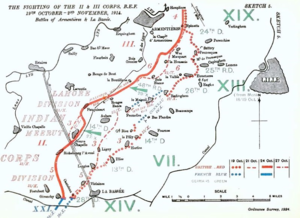Battle of Armentiéres
| Battle of Armentières | |||||||
|---|---|---|---|---|---|---|---|
| Part of the Race to the Sea on the Western Front in the (First World War) | |||||||
 La Bassée to Armentières, 19 October – 2 November 1914 |
|||||||
|
|||||||
| Belligerents | |||||||
|
|
|||||||
| Commanders and leaders | |||||||
| Sir Horace Smith-Dorrien | Crown Prince Rupprecht | ||||||
| Strength | |||||||
| 2 divisions, one brigade Conneau Cavalry Corps |
5 divisions | ||||||
| Casualties and losses | |||||||
| 5,779 | 11,300 | ||||||
|
|
|||||||
The Battle of Armentières (also Battle of Lille) was fought by German and Franco-British forces in northern France in October 1914, during reciprocal attempts by the armies to envelop the northern flank of their opponent, which has been called the Race to the Sea. Troops of the British Expeditionary Force (BEF) moved north from the Aisne front in early October and then joined in a general advance with French troops further south, pushing German cavalry and Jäger back towards Lille until 19 October. German infantry reinforcements of the 6th Army arrived in the area during October.
The 6th Army began attacks from Arras north to Armentières in late October, which were faced by the BEF III Corps from Rouges Bancs, past Armentières north to the Douve river beyond the Lys. During desperate and mutually-costly German attacks, the III Corps, with some British and French reinforcements, was pushed back several times, in the 6th Division area on the right flank but managed to retain Armentières. The offensive of the German 4th Army at Ypres and the Yser was made the principal German effort and the attacks of the 6th Army were reduced to probes and holding attacks at the end of October, which gradually diminished during November.
From 17 September – 17 October, the belligerents had made reciprocal attempts to turn the northern flank of their opponent. Joffre ordered the French Second Army to move from eastern France to the north of the French Sixth Army from 2–9 September and Falkenhayn ordered the German 6th Army to move from the German-French border to the northern flank on 17 September. By the next day, French attacks north of the Aisne led to Falkenhayn ordering the Sixth Army to repulse French forces to secure the flank. When the Second Army advanced it met a German attack, rather than an open flank on 24 September. By 29 September, the Second Army had been reinforced to eight corps but was still opposed by German forces near Lille, rather than advancing around the German northern flank. The German 6th Army had also found that on arrival in the north, it was forced to oppose a French offensive, rather than advance around an open northern flank and that the secondary objective of protecting the northern flank of the German armies in France had become the main task.
...
Wikipedia

